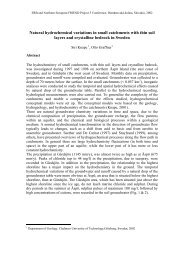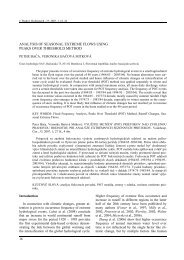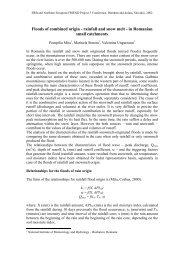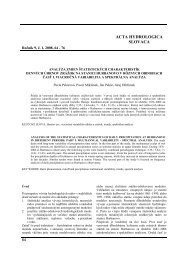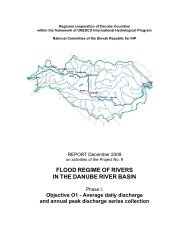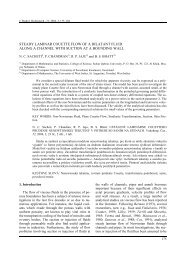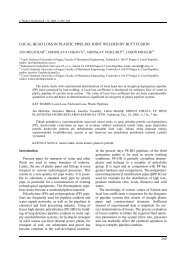TIME SERIES ANALYSIS OF HYDROLOGIC DATA FOR WATER ...
TIME SERIES ANALYSIS OF HYDROLOGIC DATA FOR WATER ...
TIME SERIES ANALYSIS OF HYDROLOGIC DATA FOR WATER ...
Create successful ePaper yourself
Turn your PDF publications into a flip-book with our unique Google optimized e-Paper software.
D. Machiwal, M. K. Jha1. IntroductionThe application of statistical hydrology in earlierdays was restricted to surface water problems, especiallyfor analyzing the hydrologic extremes suchas floods and droughts. However, during past threedecades, the statistical domain of hydrology hasbroadened to encompass the problems of both surfacewater and groundwater systems. With such abroad domain, statistics has emerged as a powerfultool for analyzing hydrologic time series. The mainaim of time series analysis is to detect and describequantitatively each of the generating processes underlyinga given sequence of observations (Shahinet al., 1993). In hydrology, time series analysis isused for building mathematical models to generatesynthetic hydrologic records, to forecast hydrologicevents, to detect trends and shifts in hydrologicrecords, and to fill in missing data and extend records(Salas, 1993).Most statistical analyses of hydrologic time seriesat the usual time scale encountered in waterresources studies are based on the following fundamentalassumptions: the series is homogenous,stationary, free from trends and shifts, non-periodicwith no persistence (Adeloye and Montaseri, 2002).Homogeneity implies that the data in the seriesbelong to one population, and hence have a timeinvariant mean. Non-homogeneity arises due tochanges in the method of data collection and/or theenvironment in which it is done (Fernando andJayawardena, 1994). Stationarity, on the otherhand, implies that the statistical parameters of theseries computed from different samples do notchange except due to sampling variations. A timeseries is said to be strictly stationary if its statisticalproperties do not vary with changes of time origin.A less strict type of stationarity (called weak stationarityor second-order stationarity) is that inwhich the first- and second-order moments dependonly on time differences (Chen and Rao, 2002). Innature, strictly stationary time series does not exist,and weakly stationary time series is practicallyconsidered as stationary time series.There are many different ways in which changesin hydro-meteorological series can take place. Achange can occur abruptly (step change) or gradually(trend) or may take more complex forms. Atime series is said to have trends, if there is a significantcorrelation (positive or negative) betweenthe observations and time. Trends and shifts in hydrologictime series are usually introduced due tonatural or artificial changes (Salas, 1993). Naturalchanges in hydrologic variables are usually gradualand are caused by a global or regional climatechange, which would be a representative of changesoccurring over the study area. Changes in monitoredvariables that may not be able to be extrapolatedover a study area could be caused by a gradualurbanization of the area surrounding the monitoringsite, changes in the method of measurement at themonitoring site, or by moving the monitoring siteeven a short distance away. The artificial change(or step change) is usually noted in the overall recordat a monitoring site, but this information is notalways presented with the sites’ data series. Thus,variables that appear to have a trend may actuallyjust represent a change in climatological conditionsnear the monitoring site. In such situations, theaffected climatological data should be modified sothat the values are better representative of the studyarea as a whole (Hameed et al., 1997). A key elementin this process is the ability to demonstratewhether a change or trend is present in the climatologicalrecord and to quantify this trend, if it ispresent.Periodicities in natural time series are generallydue to astronomical cycles such as earth’s rotationaround the sun (Kite, 1989). To identify and quantifythe periodicity in the hydrologic or climatologictime series, the time scale is to be considered lessthan a year (e.g., month or six months). In an annualtime series, periodicity effect is not discernibleand hence half-annual or monthly time series normallyencountered in hydrology can be used foranalyzing the periodicity. Lastly, the phenomenonof persistence is highly relevant to hydrologic timeseries. Persistence is the tendency for the magnitudeof an event to be dependent on the magnitudeof previous event(s), a memory effect, e.g., tendencyfor low streamflows to follow low streamflowsand that for high streamflows to follow highstreamflows; it can be considered synonymous withautocorrelation (O’Connel, 1977). Hurst (1951,1957) was the first person to describe persistencecomprehensively in his studies on a reservoir design.The phenomenon was defined in terms of aparameter called “Hurst’s coefficient”, the averagevalue of which is about 0.73 for very large samples.However, its theoretical value for an independentGaussian process to which hydrologic series areassimilated is 0.5 (Capodaglio and Moisello, 1990).If the theoretical and the observed values do notcorrespond, it is known as “Hurst’s phenomenon”.238



